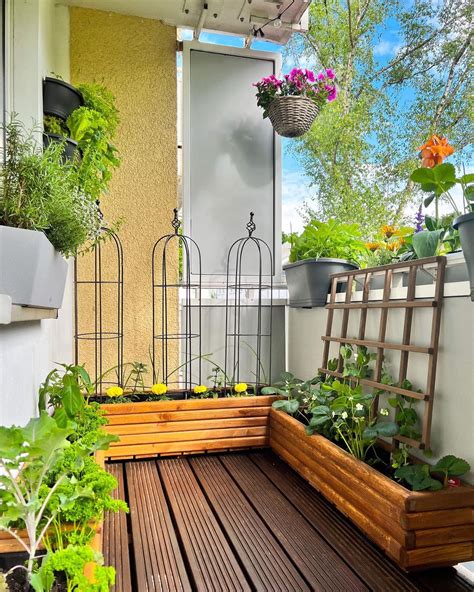Effortless Balcony Gardening: A Complete Guide for Urban Spaces
Balcony gardening offers a perfect solution for those living in urban environments who want to enjoy the beauty of nature without the luxury of a large outdoor space. With minimal effort, you can transform your balcony into a lush garden that provides joy year-round. This guide will walk you through key concepts, historical roots, and practical steps to help you master the art of minimal gardening on your balcony.
Introduction
Balcony gardening, a subset of urban gardening, has gained immense popularity as more people move into high-density cities. It allows individuals to harness the power of container gardening to cultivate plants and vegetables in small spaces, promoting outdoor living even in metropolitan settings. The benefits of balcony gardening extend beyond aesthetics, offering a sense of accomplishment, relaxation, and even health benefits by improving air quality and providing fresh produce. This guide focuses on time-saving tips and strategies for creating a beautiful and functional balcony garden with minimal effort.
Key Concepts in Balcony Gardening
- Container Gardening: Growing plants in pots or other containers is essential for balcony gardening. This allows flexibility and ensures that plants have suitable environments for growth even in constrained spaces.
- Vertical Gardening: Utilizing vertical space through wall-mounted planters or trellises is a great way to maximize space on small balconies.
- Seasonal Tips: Understanding seasonal variations and how they affect plant growth ensures better planning and healthier plants.
- Soil and Drainage: Good soil quality and proper drainage are vital to plant health and gardening success, especially in containers.
- Plant Health Maintenance: Regular but minimal effort practices can ensure that your plants remain healthy and free from pests and diseases.
Historical Context of Urban Gardening
Urban gardening dates back to ancient civilizations, where people in densely populated cities like Babylon or ancient Rome grew herbs and vegetables in pots. In modern times, balcony gardening emerged as a response to urbanization and smaller living spaces, particularly in post-industrial Europe and the U.S., where apartment living became the norm. As people sought to reconnect with nature despite limited space, techniques like container gardening became widespread, evolving into the balcony gardens we see today.
Current State of Balcony Gardening
The current state of balcony gardening is marked by a growing awareness of sustainability and the desire for self-sufficiency. More city dwellers are using their balconies to grow their own vegetables, fruits, and flowers. Technological advancements such as self-watering pots, grow lights, and smart gardening systems have also made it easier to maintain balcony gardens with minimal effort. Additionally, there’s a growing trend of community-driven urban gardening initiatives, where neighbors collaborate to grow fresh produce in shared spaces.
Practical Applications and Time-Saving Tips
To make balcony gardening easier and less time-consuming, consider the following gardening tips:
- Choose Low-Maintenance Plants: Opt for plants that require minimal watering and care, such as succulents, herbs, or hardy vegetables like spinach and lettuce.
- Use Self-Watering Containers: These containers reduce the need for daily watering and help maintain consistent moisture levels in the soil.
- Group Plants by Watering Needs: Place plants with similar water requirements in the same area to avoid over- or under-watering.
- Seasonal Tips: Rotate plants according to the seasons. Grow cool-weather vegetables like kale in the fall and spring, and heat-loving plants like tomatoes in the summer.
- Use Vertical Planters: Save floor space by growing herbs and flowers vertically on wall-mounted racks or shelves.
Case Studies: Successful Balcony Gardens
| Case Study | Location | Plants Grown | Time Spent Per Week |
|---|---|---|---|
| Small Balcony in New York City | New York, USA | Herbs (Basil, Thyme), Tomatoes | 2 hours |
| Compact Garden in Tokyo | Tokyo, Japan | Succulents, Spinach | 1 hour |
| Eco-Friendly Balcony in Berlin | Berlin, Germany | Mixed Vegetables (Carrots, Peppers), Lavender | 2.5 hours |
Stakeholder Analysis
Balcony gardening engages various stakeholders, including apartment owners, environmentalists, and local governments. Each group has its own set of concerns and contributions:
- Apartment Owners: Look for low-maintenance, aesthetic solutions that improve the living space without compromising building regulations.
- Environmentalists: Advocate for balcony gardens as a means of promoting biodiversity and reducing the carbon footprint of food transportation.
- Local Governments: Encourage urban gardening initiatives to reduce heat islands, promote sustainability, and increase food security.
Implementation Guidelines
Creating a successful balcony garden involves thoughtful planning and the right tools. Follow these steps:
- Assess Your Space: Measure your balcony to determine how many containers you can accommodate and where you can add vertical elements.
- Choose the Right Plants: Select plants that thrive in your local climate and the light conditions of your balcony.
- Invest in Good Containers: Use containers with proper drainage and adequate space for root growth. Consider self-watering options for ease.
- Set Up a Watering Schedule: Depending on your plant selection, create a watering schedule that suits their needs.
- Maintain Plant Health: Regularly inspect plants for pests, diseases, and other health issues. Use organic pest control solutions where necessary.
Ethical Considerations
While balcony gardening is an eco-friendly hobby, it is essential to consider the ethical implications, such as using non-invasive species and avoiding harmful pesticides. Sustainable practices, like using organic fertilizers and capturing rainwater, are crucial in maintaining a low environmental footprint while contributing to urban greening efforts.
Limitations and Future Research
While balcony gardening offers many benefits, it also comes with limitations. Space constraints, limited sunlight, and potential weight restrictions on balconies can all pose challenges. Future research might explore lightweight, durable materials for containers or more efficient ways to use vertical space. Moreover, technological advancements in automated gardening systems could further reduce the effort needed to maintain balcony gardens.
Expert Commentary
Experts agree that balcony gardening is a growing trend in urban environments due to its flexibility, sustainability, and health benefits. “The key to a successful balcony garden is thoughtful plant selection and smart use of space,” says John Davis, an urban gardening consultant. “Even with minimal effort, you can create a lush, thriving garden.” While the challenges are real, such as limited sunlight or space, the benefits far outweigh the obstacles, making balcony gardening a rewarding and fulfilling endeavor for urban dwellers.


